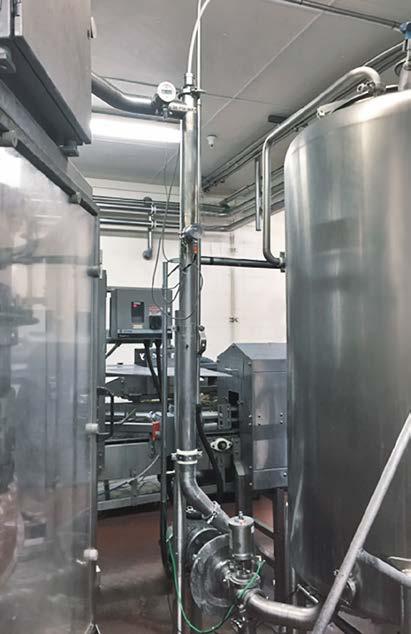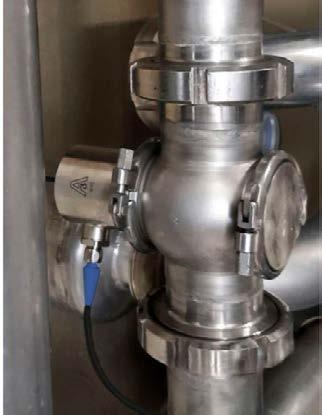
8 minute read
Technology | Pumps
OVERCOME THE CHALLENGE
BY OPTIMISING THEIR ENTIRE OPERATION AND INCREASING THEIR PLANT’S OVERALL EFFICIENCY, PC PUMPS ARE HELPING BREWERS AND DISTILLERS TO REMAIN PROFITABLE DESPITE THE PANDEMIC PRESSURES, EXPLAINS PETER MCGARIAN, MANAGING DIRECTOR AT SEEPEX UK
Despite the unprecedented impact on the UK’s hospitality sector as a result of the COVID-19 pandemic, our appetite for beer and spirits remains strong.
For breweries, this has been driven in part by consumer taste for craft beers; while in the distilling sector, there has been an increased demand for authentic and flavoured products such as artisan gin. But while brewing and distilling operations of all sizes – from artisan craft to large and highly automated – remain popular, ring fencing already tight profit margins is critical if producers are to shoulder the economic burdens of COVID-19.
The many challenges faced throughout the brewing or distilling process can be divided into three major areas: raw materials handling, production, and waste handling. In each of these, accurate control of product flow is essential to ensure the final product quality is consistently high.
Pumps are therefore integral to brewing and distilling operations. However, not all pumps are created equal.
Here, we demonstrate how switching to a progressive cavity (PC) pump can deliver efficiency, productivity and energy gains to help brewers and distillers thrive, not just survive, throughout the pandemic and beyond.
GRIST MIXING & TRANSFER
The brewing or distilling process starts by mixing milled grain (grist) with water in a vessel known as a mash or lauter tun, where the starch is converted into sugar. Traditionally, the grain is cracked and stored in a grist case and then gravity-fed into a ‘masher’, where it is mixed with hot water prior to entering the mash tun.
However, in newer or smaller breweries, the grist case often sits below the mash tun, with a conveyor system transferring the grist to the masher. This not only involves high incremental costs but can also add complexity to the conveying system, leading to mixing problems; water is often added unevenly, resulting in a mix that is not homogenous and reduces the yield.
An ideal alternative to complex conveyor systems are PC pumps in Seepex’s BT range. These offer installation and mashing-in flexibility, allowing the grist to be mixed with hot water and then pumped into the mash tun.
Comprising a feed hopper and an auger feed screw, the pitch and diameter of the auger can be adjusted for optimal product feed, ensuring a homogenous mix and a stable yield.
One producer who is already enjoying the benefits is Ringwood Brewery in Dorset. Thanks to the installation of a Seepex BT pump underneath the grist case, its grist is now carried safely, effectively and consistently to the mash tun.
The time taken for transfer has been cut in half, improving production and almost doubling mashing capacity. In addition, the pump system has been fitted with Smart Conveying Technology (SCT); an innovation from Seepex that
enables rapid dismantling and cleaning, increasing pump stator life by up to 200% and reducing maintenance time by up to 85%.
YEAST HANDLING
A critical process for any brewery or distillery is the fermentation stage; when yeast is added to the wort to convert simple sugars into alcohol. Yeast is shear-sensitive so requires very gentle and hygienic handling to avoid damaging it, which would ultimately have a detrimental effect on the taste of the beer or spirit. Choosing the right yeast pump is therefore crucial.
Peristaltic pumps are sometimes used at this stage, but their pulsating action can have a negative effect on the quality of shear-sensitive products like yeast. By contrast, Seepex’s BCF range of PC pumps offers more gentle and hygienic handling, better preserving the yeast quality for fermentation. This is because PC pumps move the product through the pump in a series of cavities, which prevents slip from the discharge back through the pump. Slip creates shear, so compared to other pump designs which have clearances between the lobes, screws or gears, PC pumps have a very low shear action.
They are also good at handling entrained air and foam; important for brewers and distillers as the yeast can gain a foamy consistency at this stage.
At the end of the fermentation process, yeast can also be recovered for re-use (known as harvesting) by discharging from the conical base of closed vessels (bottom cropping) or skimming from the surface of open vessels (top cropping). In either case, the low shear characteristics of the BCF range offer advantages over alternative pumped methods or inefficient manual procedures.
FLAVOUR & COLOUR DOSING
The addition of flavours and colours into beers and spirits must be done accurately and constantly to ensure even distribution and a consistent final product, with any additives metered in a non-pulsating manner. Positive displacement pumps are sometimes used but their pulsating action means that once they have dispensed a product, there is a pause before they can dispense again. This results in a gap in the process, which can cause uneven distribution of ingredients.
In contrast, Seepex’s PC dosing pumps (D range) are virtually pulsation-free and their output is directly proportional to the rotational speed of the pumping elements. This linear accuracy, varied using the pump speed, enables easy calibration and control.
Their ability to meter very low flow rates means that colours, flavours and portions
are all consistent, and they can also accurately meter a wide range of product consistencies – from thin to highly viscous, abrasive to sticky.

SPENT GRAINS, DRAFF, HOPS
By-products of beer and spirit production include spent grains, draff and hops. At the end of the mashing process, they need to be transferred rapidly to storage tanks or silos to enable production to continue. They are then further transported for use as animal feed, as additives in bakery products, for energy generation in biogas plants or to produce biofuel.
The methods of removing spent grain or draff vary according to the size of the brewery. Small breweries favour manual removal, whilst larger breweries or distilleries tend to use compressed air units (also known as pneumatic expeller units).
However, brewers and distillers can significantly reduce their costs by pumping these residual materials instead. Open hopper PC pumps with auger feed systems can transport the spent grain or draff within a closed pipe system over hundreds of metres. And as expeller units account for one of the highest utility costs in the industry, this has the additional advantage of reducing energy consumption. technology is also ideal for this application. SAI can efficiently convey 15-40% dry solids (ds) spent grains, draff and hops in plugs of 20-30m length, over distances of up to several hundred metres using controlled air pulses.

SAI combines progressive cavity pumping with pneumatic dense-phase conveying to increase process efficiency and productivity, as well as reducing energy consumption.
In a spent grain handling test at a UK brewery, conveying efficiency using SAI was evaluated to assess the air consumption savings compared to the existing pneumatic expeller. The test demonstrated the potential to reduce air consumption by ~90% for the mash tun discharge of spent grain into the bulk storage, and by ~80% for the hops discharge.
Seepex BCF progressive cavity pumps are ideal for gentle and hygienic handling of shear sensitive products like yeast A flexible alternative to expeller units, Seepex open hopper pumps are used for spent grain handling as well as grist mixing and transfer
In conclusion, by moving away from traditional and inefficient product handling methods towards innovative, problem-solving PC pump solutions, brewers and distillers can maintain their product quality, reduce their energy consumption and increase their production capacity. By optimising their entire operation and increasing their plant’s overall efficiency, PC pumps are helping brewers and distillers to remain profitable despite the pandemic pressures.
OPTIMISE THE INLINE BLENDING PROCESS
IN THIS PIECE, LEICESTER-BASED OEM AUTOMATIC SHOWCASE THE BENEFITS A IRM-11 REFRACTOMETER CAN PLAY IN THE BLENDING PROCESS

The IRM-11 refractometer is integrated into the process In many applications, the inline Brix analysis of products enables automated and highly accurate process control and quality monitoring.
Especially when blending and filling juices, syrups, nectars, soft drinks, and other beverages, the refractometer IRM11 from Anderson-Negele can: u Measure and monitor the quality of the components with high precision u Control the dosage during the blending of the products with high precision u Ensure during filling that the correct product with the correct quality is in the process
THE APPLICATION
In beverage production, syrups, juice concentrates, or other components are usually blended with water according to specified recipes, then stored in stacking tanks, and finally filled into bottles or containers, which are often productspecific. If a preliminary component, e.g., a juice concentrate, does not precisely meet the specifications or if the blending process itself is incorrect, e.g., caused by a wrong valve switching, the entire product may be defective. It is also possible that the wrong product is bottled due to incorrect phase transition. If this is only detected during the final quality control, a complete production batch may have to be disposed of. With a refractometer, each process step can be controlled by measuring the dissolved sugar in the liquid. If this Brixcontrol is made with manual samples and hand refractometers, this requires a very high workload for the personnel, e.g., every 20 minutes. In addition, an error can only be detected afterward, so that the production quantity between two samples or a complete filling batch can be affected and must be disposed of.
THE SOLUTION
The IRM-11 refractometer is integrated into the process and continuously measures the Brix value, which is the concentration of dissolved substances in the products such as sugar, with high accuracy.
This allows the user to differentiate each component or product. Three essential features of the IRM-11 are the basis for its highly efficient process analysis: u The measurement is inline, temperature compensated, and continuous (measuring interval adjustable from 2 s). This saves labor costs for manual sampling and ensures correct measurement results in real-time. u When measuring manually, the entire manufactured product between two measurements can be defective. IRM-11 can avoid these product losses due to its permanent measuring method u The compact, all stainlesssteel design, and the simple, flush installation without bypass ensure maximum operation dependability in all applications.











